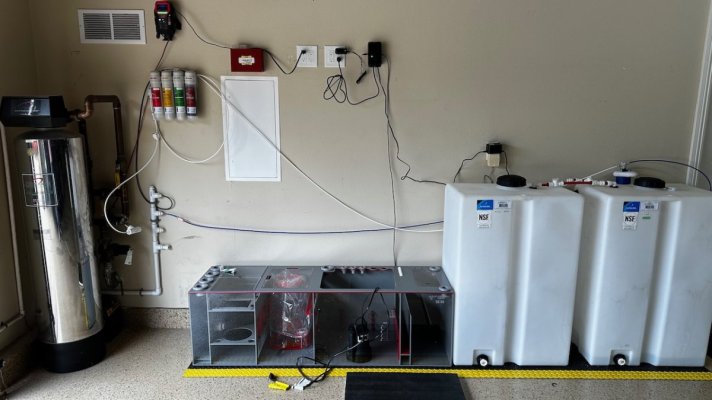Greetings. Back in 2018, I posted a walk-through of the 300 gallon reef tank I had built out over the prior few years. I waited until was fully up and running because I often prefer coming across build threads that are done – like binge watching a show that already has a few seasons in the bank.
Not too long after posting that build thread, we moved and sold the tank with the house. Since my wife and I have traveled a lot in the years since, I could never seem to find the right time to get my mind around a new tank build, but the ideas have been percolating and I finally decided to bite the bullet. This time, rather than wait until the tank is up and running, I’m going to try to post as I go. I gave the build out a head start over the posts, but I’m going to catch up quickly and then post more or less in real time so I can change plans along the way if anyone less rusty in reef best practices chimes in with better ideas than my own.
Before I get into the details of the build, here’s the concept and goals: I'm using the prior build as a starting point and adjusting from there. So the display tank will be in the 300ish range and I'll include a large sump and separate large refugium. My focus will be on SPS corals but it will be mixed with some LPS and small soft corals low in the tank. Emphasis will be on color and growth of corals so I’ll be lighting accordingly and plan to incorporate robust systems to maintain ultra-low nutrient levels while still providing ample nutrition and will dose for ionic balance and coral coloration.
A primary driver of the design will be automation. The prior tank was highly automated and this one will seek to incorporate the best ideas from that experience and a few new advances from recent product offerings. I still travel quite often so I’ll invest the upfront time to ensure automation while I’m away.
Overall, that will mean that at least the following major components in addition to the display tank:
Not too long after posting that build thread, we moved and sold the tank with the house. Since my wife and I have traveled a lot in the years since, I could never seem to find the right time to get my mind around a new tank build, but the ideas have been percolating and I finally decided to bite the bullet. This time, rather than wait until the tank is up and running, I’m going to try to post as I go. I gave the build out a head start over the posts, but I’m going to catch up quickly and then post more or less in real time so I can change plans along the way if anyone less rusty in reef best practices chimes in with better ideas than my own.
Before I get into the details of the build, here’s the concept and goals: I'm using the prior build as a starting point and adjusting from there. So the display tank will be in the 300ish range and I'll include a large sump and separate large refugium. My focus will be on SPS corals but it will be mixed with some LPS and small soft corals low in the tank. Emphasis will be on color and growth of corals so I’ll be lighting accordingly and plan to incorporate robust systems to maintain ultra-low nutrient levels while still providing ample nutrition and will dose for ionic balance and coral coloration.
A primary driver of the design will be automation. The prior tank was highly automated and this one will seek to incorporate the best ideas from that experience and a few new advances from recent product offerings. I still travel quite often so I’ll invest the upfront time to ensure automation while I’m away.
Overall, that will mean that at least the following major components in addition to the display tank:
- Large sump to accommodate robust nutrient filtration
- Stand alone refugium – to provide a source of pods to feed the tank and possibly for nutrient export (if I don’t do a zeovit system – more on that below)
- Multiple dosing containers and pumps. I think the last tank used 14 channels of dosing pumps but I believe I can make this work either with 11 (calcium, alkalinity, magnesium, balling part c, vinegar, 4 Korallen Zucht 4-part coral, 2 channels for automatic low-volume water changes) or with a few less if I make it a zeovit system.
- Computer automation (Apex, Hydros or Profilux)
- Large reservoirs for RO water and saltwater
- Backup power systems
- High par lighting
- Automated feeding
- Remote monitoring
- Probably several systems I haven’t thought through yet.
As I post this build, I am reminded of how helpful it has been to find all the build threads on R2R (including my own) so I’m going to try to journal this in some detail to make it useful for other reefers and the future me I picture tackling another build in 10 years and trying to remember what I used to know about doing this.
So follow along and let’s see where this goes . . .

















